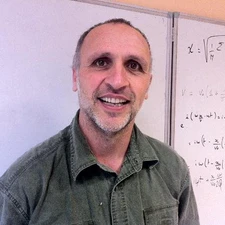Yanick Ricard

The 2012 Augustus Love Medal is awarded to Yanick Ricard for fundamental contributions to geodynamics through studies of how geoid, true polar wander, topography, seismic tomography and plate motions can be used to probe the mantle viscosity structure, mantle mixing and convective flow.
Yanick Ricard is author of more than 90 publications in the most prestigious international journals. His exceptional mathematical insight, his intellectual liveliness, and his generous personality make him a most talented and pleasant person to collaborate with, as demonstrated by his numerous collaborations with scientists the world over. Key to Ricard’s success is a unique combination of innate creativity, great physical intuition, and impressive mathematical prowess. His contributions are always highly original, often producing results that challenge consensus and guide research into new directions. Even from his PhD studies, Ricard was at the forefront of demonstrating how geoid, topography, seismic tomography and plate motions can be used to probe the mantle viscosity structure and convective flow. His 1984 paper on geoid and stresses is a seminal work. Synchronous with the famous papers of Hager (1984), it is co-credited with inferring how the geoid is explained by the support of slabs at internal boundaries with moderate viscosity jumps. His later papers, including the explicit reference model 3-SMAC, a seismic a-priori model of the upper mantle, continued to develop the integration of multiple datasets into geodynamic models. Another of his early papers, with Doglioni and Sabadini (1991), shows how vertical vorticity can be generated by lateral variations in viscosity, and how this process can account for the mean westward motion of the plates in the hot spot frame, showing how geodynamic features not obviously associated with plate motions can be understood using sophisticated ideas from fluid mechanics. Ricard’s work on large-scale geoid anomalies and mantle heterogeneity is very elegant. Jointly with Mark Richards he was the first to demonstrate that the largest gravity anomalies can be accounted for by old subducted lithosphere ponding at the base of the mantle and reflecting the history of Mesozoic and Cenozoic subduction. This emphasized the importance of tracking past plate motions and mantle convection currents over a significant length of time. And it opened the way for time-dependent geodynamic earth models. The issue of true polar wander remains controversial in plate tectonic reconstruction and paleomagnetism. Ricard’s model (1992) of how even small mass anomalies cause rotational adjustment of the Earth’s spin state remains one of the most commonly accepted theories on the problem to date. The source of mantle heterogeneity and geochemical mixing is also one of the great enigmas in geodynamics, and again Ricard’s work is some of the most highly regarded. His works with Coltice (1999) on ocean crust accumulating in D” and providing the source for OIB, and with Ferrachat (1998) on the chaotic dynamics of mixing are seminal and often cited. Ricard’s work on thermodynamic models of mantle mineralogy with Matas (e.g., 2005) demonstrates his great diversity as a physicist; this work produced innovative predictions, including that solid-solid phase changes in the transition zone can induce seismic attenuation at low frequencies (2009) and that the mantle geotherm departs from adiabaticity. Since 2000 Ricard has become interested in the dynamics of two phase flow. Many problems in the Earth Sciences involve the relative motion between a low viscosity fluid, like a melt, and a material with much higher viscosity. Together with Dave Bercovici he derived the governing equations to this fundamental problem, which has implications in many different contexts, from mantle dynamics, volcanism, mineralogy and reservoirs. From this work he drew original conclusions on damaging and the link between grain-size and rheology. Most recently, Ricard extended his approach to the complex 3-phase problem of core formation. He thus discovered a new type of mechanism, intermediate between diapirism and porosity wave, with important implications for the chemical evolution of the early Earth and other planets. In addition to the superb quality of his research, Ricard has contributed generously to community service, through leadership positions at the École Normale Supérieure, the Université de Lyon, and CNRS, as well as through editorships for leading journals in our field, and his role as an enthusiastic and generous mentor for the next generation of scientists.
